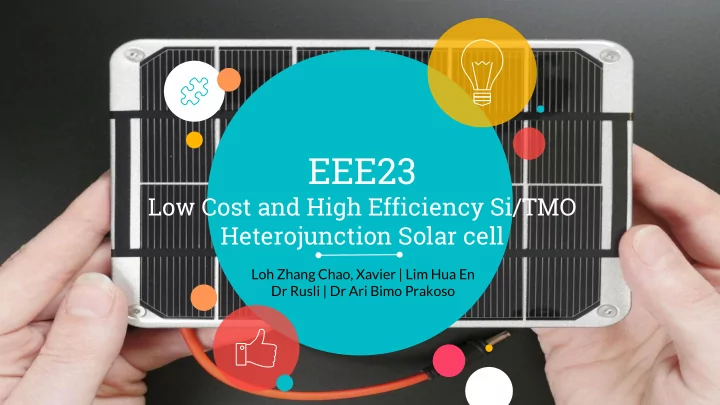

EEE23 Low Cost and High Efficiency Si/TMO Heterojunction Solar cell Loh Zhang Chao, Xavier | Lim Hua En Dr Rusli | Dr Ari Bimo Prakoso
1. Rationale behind our research Why we decided to embark on this research
3 Traditional Solar Cells Rationale ○ High Temperature - during doping of P- type and N-type Si junctions ○ High Costs ○ High Payback Time of > 6 years
4 Unfavourable for widespread application
Background of our Research Transition Metal Oxides such as MoO 3 , V 2 O 5 & Cu 2 O have shown favourable properties as P-type Si junction replacements ➢ High Work Functions that help form strong electronic barrier with nSi ➢ Lower Temperature of production ➢ Lower Cost that allows greater deployment ➢ More stable than other organic polymer material
“ 6 Research Goal - To identify which TMO is the best out of the three to spearhead future research into TMO/nSI Solar Cell research
“ 7 Methodology Fabrication of Sample Compare results Deposition Shadow of layers Wafer Cleaning of Characterisatio Mask -Back Cutting Samples n of Solar Cell -Silver Contact Contact -TMO -ITO
8 Structure of our Solar Cell
Some Equipment Used for Fabrication / Characterisation Electron Beam Evaporation | Radio Frequency Sputtering | Solar Simulator & Machine Machine Keithley Sourcemeter
Deposition of Deposition of Obtaining Photovoltaic - Back Contact - TMO - ITO Parameters to compare - Silver Contacts with Shadow between solar cells Mask Electron Beam Evaporation | Radio Frequency Sputtering | Solar Simulator & Machine Machine Keithley Sourcemeter
Specifics on how we used the equipment Power intensity set at 1. 100mW/cm 2 with fixed Sample Size of 1 cm 2 2. 2 Probe Method for more realistic results Solar Simulator & Keithley Sourcemeter
3. Characterisation of samples Values obtained from characterisation and analysis
- Short Circuit Current 4 different PV density (Jsc) parameters measured - Open Circuit Voltage (Voc) - Fill factor (FF) - Efficiency (PCE)
Short Circuit - Measures current Current Density at 0V (Jsc) - Dependent on light absorption of solar cell and carriers generated and collected
- Measures voltage at 0A Open Circuit - Dependent on Voltage (Voc) saturation current, which depends on recombination of carriers
- Measures the ratio of maximum power Maximum Fill Factor (FF) Power to Isc x Voc - Allows us to determine the amount of series, shunt resistance in the cell
- The ratio of output to input power, Efficiency calculated through (PCE) Pmax/Pin - The main point of comparison between different solar cells
Results Data and Analysis
19 Jsc/ mA cm - Structure Voc/V FF/% PCE/% 2 Results Collected 27.8 0.570 59.8 9.5 MoO3 26.7 0.568 57.0 8.6 V2O5 30.1 0.261 37.3 2.9 Cu2O Without 14.8 0.054 24.3 0.2 TMO
- Comparable Struct values for all 3 Jsc/ mA Analysis - Jsc Voc/V FF/% PCE/% ure cm -2 - Cu 2 O has a slightly 27.8 0.570 59.8 9.5 MoO3 higher Jsc value, 26.7 0.568 57.0 8.6 V2O5 which could be due to higher 30.1 0.261 37.3 2.9 Cu2O capability in Withou 14.8 0.054 24.3 0.2 t TMO photon carrier generation
- MoO 3 has highest Struct Voc value, Jsc/ mA Analysis - Voc Voc/V FF/% PCE/% ure cm -2 suggesting lowest 27.8 0.570 59.8 9.5 rate of MoO3 recombination 26.7 0.568 57.0 8.6 V2O5 - Cu 2 O’s low Voc 30.1 0.261 37.3 2.9 Cu2O value may be due Withou 14.8 0.054 24.3 0.2 to higher t TMO recombination current in the cell
- MoO 3 also has a Struct high FF, which Jsc/ mA Analysis - FF Voc/V FF/% PCE/% ure cm -2 suggests the solar 27.8 0.570 59.8 9.5 cell has very little MoO3 series 26.7 0.568 57.0 8.6 V2O5 resistance/more 30.1 0.261 37.3 2.9 Cu2O shunt resistance Withou 14.8 0.054 24.3 0.2 - Cu 2 O’s lower FF t TMO could be due to higher series resistance in cell
- MoO 3 has the Struct highest PCE value Jsc/ mA Analysis - PCE Voc/V FF/% PCE/% ure cm -2 of 9.5%, showing 27.8 0.570 59.8 9.5 its potential MoO3 26.7 0.568 57.0 8.6 V2O5 - Cu 2 O’s lower PCE 30.1 0.261 37.3 2.9 value of 2.8% was Cu2O mainly due to the Withou 14.8 0.054 24.3 0.2 t TMO lower Voc and FF values hindering max power
4. Conclusion Summary of Analysis and areas for further research
- About 20% reduction in cost Conclusion - MoO 3 achieved the best Voc, FF and PCE values, highlighting its favourable properties for use - Despite relatively lower PCE values, MoO 3 displays potential for future research and large improvements
- Vary thickness of ITO Areas for and TMO layers to better optimise solar future cell research - Use single wavelength analysis to better analyse the structure of the solar cell, absorption probabilities at different sections - Utilise alternative fabrication methods like spin coating
Recommend
More recommend